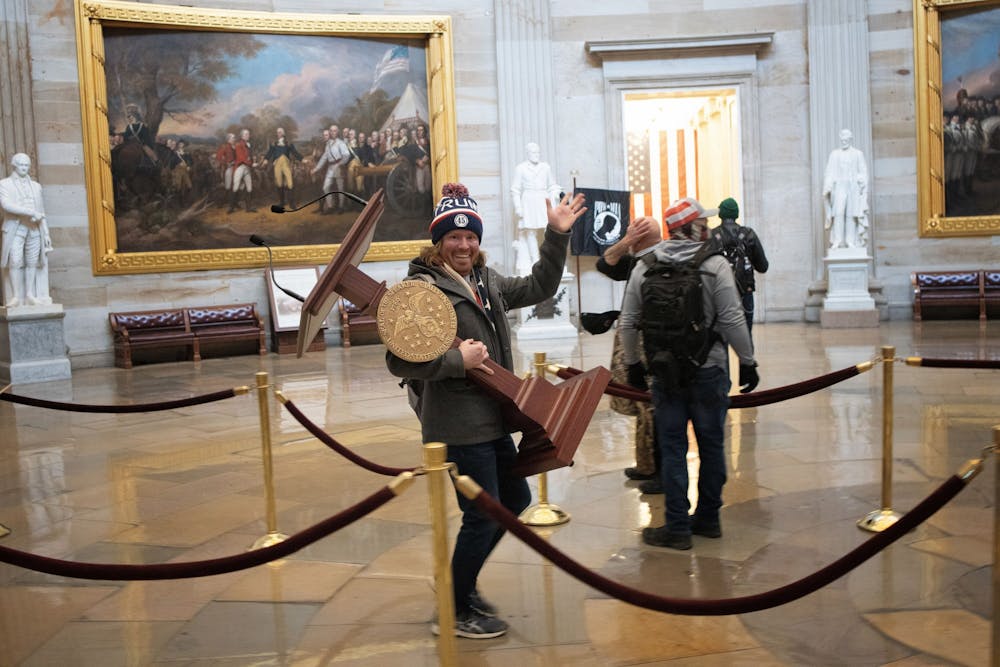The world is familiar with the events that occurred in the U.S. Capitol on Jan. 6. When pro-Trump rioters broke into the building, they didn’t just deepen the scars of an emotionally damaged nation – they left behind physical damage, too.
Just days after the riot, art curators have already begun to survey the Capitol to search for any damage done to the works of art that grace the rooms and hallways of the building.
To be blunt – the people who invaded the Capitol building are despicable. One of the most heartbreaking and horrifying ideas about the whole event, though, is that these people thought they were doing the right thing. They thought that they had a cause to fight for.
They genuinely thought that they were dutiful Americans that are knowledgeable and respectful when it comes to this nation's history.
But they aren’t. They never were. And they never will be. And that’s further symbolized in the damage they left in the Capitol building.
After all, if they love this country so much and have so much respect for its history, why would they march into the Capitol building, one of the foremost symbols of this country, and put old, expensive works of art at risk of being ruined?
Barbara A. Wolanin used to be the curator of the Architect of the Capitol, which takes care of the art and architecture of the Capitol building. Paintings and sculptures she looked after for 30 years were suddenly put at risk.
And not everything fared so well.
President Zachary Taylor’s bust was stained with blood. A frame was found on the floor with the piece of artwork itself gone. Someone ripped up Chinese scrolls. Someone else stole a photo of the Dalai Lama.
The sad part? Wolanin said it could’ve been worse.
Worse. It could’ve been worse.
Wolanin witnessed live on national television 30 years of her life – the time she spent as curator at the Capitol – becoming subjected to destruction.
And the fact that not a single person in the riots thought of the people who put in the work behind these pieces is simply symbolic of the carelessness of these rioters.
They don’t care that someone made those works of art. They don’t care that someone carefully selected them to be in the Capitol. They don’t care that someone looks after them every day.
They don’t care that centuries of historical figures have graced those halls. They don’t care that this singular building is symbolic of this genuinely precious and fragile American democracy.
All they cared about was making a statement. And, I just want to ask – what exactly was your statement, rioters? And did you get your point across?
This event has already become so cemented in our history that Capitol preservationists are actually considering leaving some of the damage to represent the tragedy that was Jan. 6. Obviously, that’s a risk – there’s a line between preservation and glorification. I’m still debating it myself, but I lean toward leaving one or two items damaged. Certainly not all of it.
But what we do know for sure is that it was so scarring – so damning – that preservationists are arguing that future generations need to be able to witness for themselves even just a small sampling of how horrific it was.
Blood smeared on the bust of Zachary Taylor is forever ingrained in my brain. It’s an image so symbolic and genuinely haunting it makes me sick to my stomach. But it’s an image that will never leave me.
You know what, rioters? None of this made you brave. You didn’t make the positive impact you thought you were making – you wreaked havoc on a nation already in crisis in more ways than one.
The works of art that have lined the walls of the Capitol for years are not only products of someone’s hard work, but they’re relics of American history. Not only do they preserve and record history, but they remind us of the good and bad moments of our past.
They’re vital puzzle pieces in this country’s history. And losing them would be devastating.




